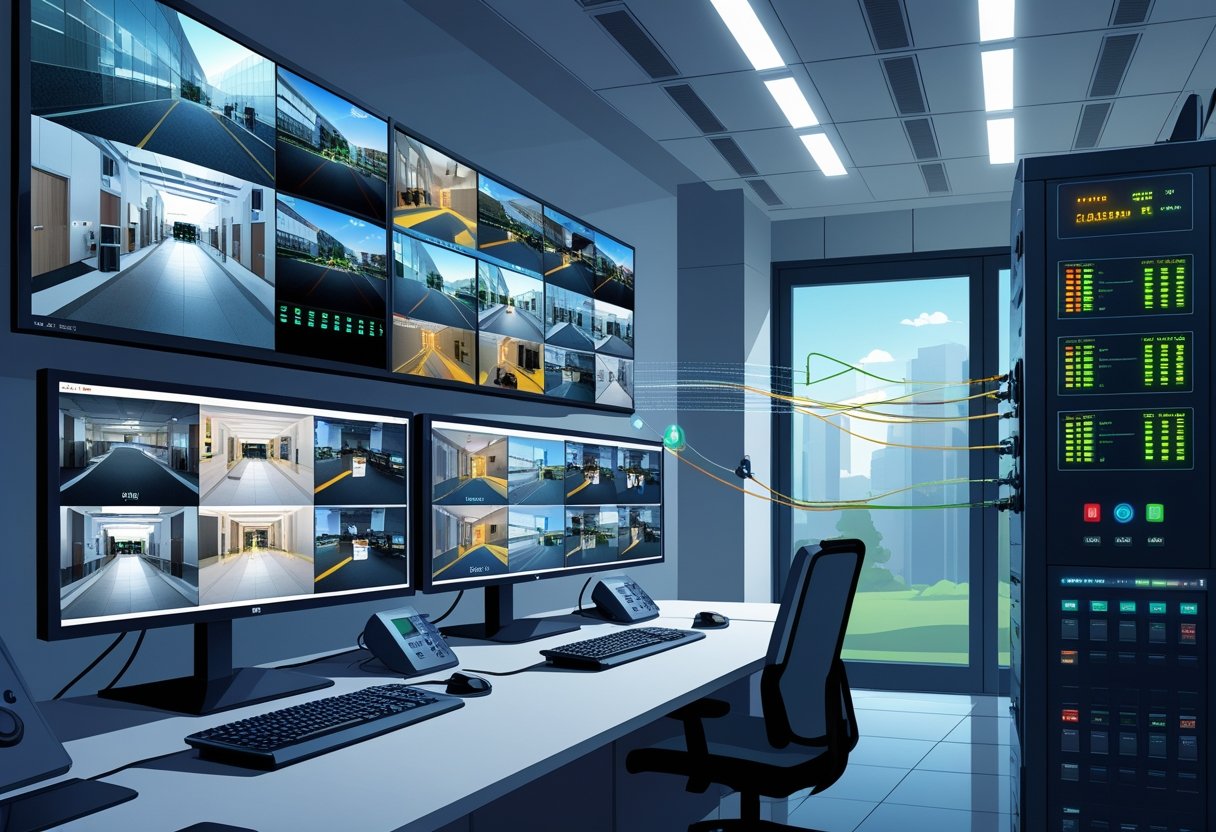Integrating CCTV with your fire alarm system creates a robust safety network that enhances emergency response capabilities. By combining these technologies, you gain a comprehensive solution that not only detects fires but also provides visual verification in real time. This integration allows you to monitor incidents as they happen, ensuring you can take appropriate action quickly.
For businesses in the greater Houston area, this combined approach can significantly reduce response times during emergencies. With both systems working in tandem, your security and fire safety measures become more efficient, offering peace of mind that you are well-prepared for any situation.
Understanding the advantages of this integration can empower you to make informed decisions about your safety protocols. As you explore this topic further, you will discover practical strategies that can enhance your property’s overall security and protection against fire hazards.
Understanding Integrated CCTV and Fire Alarm Systems
Integrating CCTV with fire alarm systems creates a comprehensive safety solution. This combination enhances both surveillance and emergency response capabilities within your space, ensuring you are equipped to manage incidents effectively.
Definition and Core Concepts
Integrated CCTV and fire alarm systems work together to provide real-time monitoring and threat detection. The core concept revolves around connectivity; fire alarms trigger CCTV cameras to focus on affected areas, offering visual insights during emergencies. This synergy enables rapid assessment of situations, allowing for informed decision-making. By leveraging advanced technology, these systems operate on a centralized platform, simplifying management while enhancing overall safety. In the modern safety landscape, this integration is becoming increasingly essential for both residential and commercial properties.
Key Components and Technologies
Several key components make up an integrated CCTV and fire alarm system:
- CCTV Cameras: High-definition cameras that monitor and record activity. They can be strategically placed to cover critical areas.
- Fire Alarm Systems: These include smoke detectors, heat sensors, and manual pull stations, which detect fire hazards.
- Integration Software: This allows both systems to communicate seamlessly. In case of a fire alarm activation, the software triggers the relevant CCTV cameras.
- Monitoring Station: A centralized location where operators can view live feeds and receive alerts about emergencies.
Through these components, you can ensure a cohesive response to emergencies, enhancing safety across your premises.
Comparing Standalone and Integrated Solutions
When considering fire safety measures, it's crucial to compare standalone systems with integrated solutions.
- Standalone Fire Alarm: Primarily alerts occupants of a fire, lacking visual assessment. Response times can be delayed due to the absence of real-time monitoring.
- Integrated Systems: Combine fire detection with CCTV, providing immediate visual feedback during alarms. This means you can assess the situation effectively and deploy emergency services faster.
In the Greater Houston area, opting for integrated solutions maximizes safety and can reduce the likelihood of false alarms. The comprehensive nature of these systems makes them preferable for businesses and homes alike.
Benefits of Integrating CCTV with Fire Alarm Systems
Integrating CCTV with fire alarm systems significantly enhances safety by providing comprehensive coverage and a rapid response mechanism during emergencies. This combination improves your building's security, streamlines operations, and ensures that appropriate measures are taken promptly in critical situations.
Enhanced Emergency Response
The integration of CCTV and fire alarm systems allows for quick action when emergencies occur. When the fire alarm is triggered, the CCTV system provides real-time video feeds of the affected areas. This capability enables emergency responders to assess the situation accurately before arrival.
Such preemptive information aids in determining the best course of action. It minimizes confusion and enhances coordination among emergency teams, leading to a more efficient response. This synergy contributes to preventing damage to property and potential loss of life.
Real-Time Monitoring and Automated Alerts
With integrated systems, you gain the advantage of continuous surveillance, which allows for real-time monitoring of your facilities. When a fire alarm activates, the system can automatically send alerts not only to emergency responders but also to designated personnel within your organization.
These automated alerts ensure that you and your team are aware of any incidents immediately. It enables you to initiate evacuation procedures faster, safeguarding all personnel within the building. Additionally, video feeds can be accessed remotely, providing crucial situational awareness.
Operational Efficiency and Cost Savings
Integrating these systems streamlines your operations by consolidating multiple security functions into one cohesive platform. This consolidation simplifies management and monitoring, allowing for quicker decision-making and fewer resources spent on separate systems.
Moreover, an integrated approach can reduce costs in the long term by lowering the likelihood of false alarms and enhancing response efficiency. With fewer disruptions and improved safety measures, your overall operational costs decrease. Investing in this technology not only enhances fire safety but also contributes to the economic health of your organization.
Key Features and Technologies in Integrated Systems
In an integrated CCTV and fire alarm system, several critical features enhance safety and streamline operations. Focusing on advanced technologies ensures effective monitoring and response. Here are key features to consider when evaluating such systems.
Video Analytics and Motion Detection
Video analytics is a powerful tool that improves surveillance effectiveness. Utilizing algorithms, it can analyze video feeds in real time to detect unusual behavior or motion. This means you can receive alerts when unauthorized access occurs or if smoke is detected.
Features like object recognition help distinguish between people and inanimate objects. For instance, if a fire alarm activates, the system can determine whether it is due to legitimate activity or a potential emergency.
By integrating motion detection with fire systems, you enhance the capability to respond quickly. This synergy ensures that personnel are alerted even before human monitoring can occur, significantly improving response times.
Integration with Access Control
Integrating access control systems with your fire alarm and CCTV setup is essential for comprehensive safety. When you have biometric scanners or card readers tied into the system, you can monitor who enters and exits your building.
Access control integration can also implement lockdown procedures during an emergency. If a fire is detected, the system can restrict entry to affected areas, keeping individuals safe.
Additionally, combining access control with video surveillance provides a clearer picture. You can correlate access logs with video footage to enhance accountability and security. This integration is particularly effective in the greater Houston area, where you might need regional specifications tailored to your needs.
Fire Alarm Panel and NVR Connectivity
Connecting the fire alarm panel to a Network Video Recorder (NVR) creates a unified system. This setup allows you to manage and monitor all components from a single interface. You can streamline data management and improve response coordination.
With NVR connectivity, video footage is precisely time-stamped with fire alarm events. This feature allows for faster investigations and response assessments. When an alarm triggers, the corresponding video can be reviewed instantly, ensuring you have all relevant information.
In an integrated environment, you can also access these features remotely. This capability enables ongoing monitoring and management of systems, ensuring safety even when you are not physically present at the site.
Design Considerations and Implementation Strategies
When integrating CCTV with fire alarm systems, specific design considerations and implementation strategies play a crucial role in enhancing overall safety. Focus on the system architecture, existing infrastructure, custom solutions, and regulatory compliance to ensure an effective integration.
System Architecture and Placement
The system architecture must allow seamless communication between CCTV and fire alarm systems. Begin by defining a central control hub that connects both systems for real-time monitoring and alerts.
Placement of cameras is critical; optimal positioning should cover key areas, such as exits, hallways, and equipment storage. Ensure cameras are mounted high enough to avoid tampering but positioned to capture clear visuals.
Consider using IP cameras that can easily connect to fire alarm systems. This allows for more straightforward integration and flexibility in expanding your surveillance capabilities. Performing a detailed site assessment will guide strategic placements and coverage.
Integration with Existing Infrastructure
You must evaluate your current fire safety systems to determine compatibility with CCTV integration. Identify existing hardware and software capabilities before proceeding. Analyzing network bandwidth is necessary, as adding CCTV may strain resources.
Focus on installing a unified management system that can handle both fire alarms and CCTV feeds. This will streamline operations and enhance response times during emergencies.
Collaborating with experienced professionals ensures that integration does not disrupt your existing operations. They can provide insights into retrofitting existing systems to enhance communication and overall performance.
Customizing Solutions for Different Environments
Different environments dictate unique integration needs. In commercial buildings, for example, high-traffic areas call for a more robust camera system that can handle extensive monitoring.
Consider using weather-resistant cameras in outdoor settings or specialized models for areas where hazardous materials are present. In residential settings, simpler systems may suffice, but you should still ensure all critical areas are covered.
Customizing alerts is also essential; configure your systems to prioritize fire alarms over other notifications in case of a fire event. This tailored approach ensures that your systems are responsive to the specific demands of your environment.
Ensuring Regulatory Compliance
Compliance with local fire safety regulations is non-negotiable. Research the requirements pertinent to fire safety systems in the greater Houston area. This includes ensuring that your integration meets necessary standards for both CCTV and fire alarm systems.
Working with certified professionals familiar with local codes can prevent potential legal issues. Ensure documentation and testing are conducted regularly, adhering to guidelines like NFPA standards for fire alarm systems.
Incorporating periodic audits of your integration will further solidify compliance. Keeping abreast of any updates in fire safety regulations ensures your systems remain effective and lawful over time.
Addressing Challenges in CCTV and Fire Alarm Integration
Integrating CCTV with fire alarm systems presents specific challenges that require careful consideration. You need to address false alarms, ensure interoperability among devices, and maintain system reliability to optimize performance and safety.
Managing False Alarms
False alarms pose a significant challenge in fire alarm systems, leading to unnecessary panic and costly responses. To mitigate this, integrate CCTV with your fire detection systems for visual confirmation before alerting emergency services.
Establishing clear protocols regarding alarm verification can reduce false activations. Incorporate standards for video monitoring that focus on identifying smoke or fire. This dual-layer approach enhances the accuracy of alerts and minimizes disruption.
Interoperability Between Devices
For a successful integration, your CCTV and fire alarm systems must communicate effectively. Ensure that both systems have compatible protocols for seamless data exchange. Working with reputable manufacturers who provide interoperable devices is crucial.
Consider using a centralized security management platform. This allows for a unified interface where both systems can be monitored, providing real-time data. Regular updates to software and firmware will also guarantee ongoing compatibility and performance.
Maintenance and Reliability
Consistent maintenance of your integrated system is vital for performance. Regular checks on both fire detection and CCTV systems help identify any potential issues before they escalate. Schedule periodic reviews to test functionality, including camera angles and sensor responsiveness.
Training your staff on the importance of system upkeep can enhance reliability. An informed team will recognize early warning signs of malfunctions, leading to quicker interventions. Choose a service provider that specializes in security measures within the greater Houston area for local expertise. Never underestimate the importance of reliability in safeguarding your property and personnel.
Frequently Asked Questions
When considering the integration of CCTV with fire alarm systems, it's essential to understand the various benefits, safety enhancements, compatibility requirements, and protocols involved. Addressing these key areas will clarify how integration can create a more effective security environment.
What are the benefits of integrating CCTV with fire alarm systems?
Integrating CCTV with fire alarm systems provides enhanced monitoring capabilities. You can visually verify alerts generated by fire alarms, reducing the likelihood of false alarms.
Additionally, real-time footage can assist emergency responders, allowing for quicker assessments and actions during incidents. This synergy promotes a proactive approach to safety.
How does integration enhance the safety and security measures within a building?
The integration allows for continuous surveillance of critical access points and vulnerable areas. This capability ensures that potential fire hazards are monitored actively.
Furthermore, security personnel can respond swiftly to both security breaches and fire alarms, improving the overall emergency response strategy.
What are the essential considerations for compatibility between CCTV and fire alarm technologies?
You need to ensure that both systems communicate effectively. Check for compatibility in protocols and technologies, such as IP-based systems and video management software.
Additionally, evaluate the bandwidth requirements because high-quality video streams necessitate adequate network capacity.
Which protocols are commonly used for integration of CCTV and fire alarm systems?
Several protocols facilitate the integration of CCTV and fire alarm systems. Common ones include ONVIF, which standardizes communication between devices, and RTSP for streaming video.
These protocols enable different manufacturers' equipment to work together seamlessly, enhancing the effectiveness of the integrated system.
Can existing fire alarm systems be upgraded to integrate with CCTV, and what does the process entail?
Yes, existing fire alarm systems can often be upgraded for CCTV integration. You should assess the current infrastructure and identify required components for compatibility.
The upgrade may involve installing new software, configuring network settings, and ensuring that all devices meet the necessary standards for effective communication.
What are the best practices for maintaining and testing an integrated CCTV and fire alarm system?
Regular maintenance is crucial for optimal performance. Schedule routine inspections of both systems to identify and resolve issues promptly.
Testing the integration periodically will ensure that video feeds activate during fire alarms as intended. Documenting any discrepancies will help maintain a reliable security infrastructure.
.svg)



.svg)


.svg)



